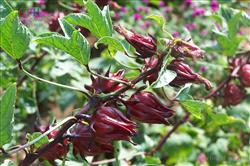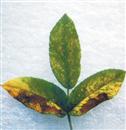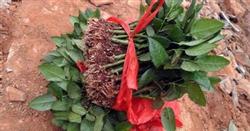Key points of cultivation techniques of Roselle

Roselle is Malvaceae Hibiscus, is an annual herb, originating in Sudan, Africa. Its purple stem, green leaves, yellow flowers, red fruits, gorgeous color, is currently the world's most ideal natural plant health drinks, seeds can be extracted oil, medicinal value is very high, but also edible, stem can be used as feed and fuel, can be described as a whole treasure. In order to study this technology, Hongta District Agricultural Technology Station introduced Roselle for planting in 2011 and achieved success. The technology is introduced as follows: I. Soil requirements: Roselle is a plant that is afraid of flood and drought, and should be planted in sandy loam with sunny, deep soil layer and good drainage. 1000- 1500kg farm manure is applied per mu. II. Planting density: According to soil fertility, plant spacing: (0.6×0.8) cm, sowing 1300-1500 ponds per mu is appropriate. 3. Sowing time: Soak seeds for 12 hours before sowing, sow from mid-late April to early May, and sow 3-4 seeds per pond; transplant seedlings in nutrient pots, transplant in time when the seedlings are 12-15 cm high. 4. Field management: 1. Timely pest control: 5-7 days after sowing, spraying with 2.5% beta-cyhalothrin 50ml/mu to control pests. Control of root neck rot: 5% Baodining 5g, 2% kasugamycin 30ml and 15kg water were used to drench roots twice. Pesticide spraying must be carried out before flowering. Pesticide spraying is strictly prohibited during flowering to avoid drug poison remaining in calyx and affecting product quantity. 2. Timely thinning, seedling fixing and pruning: when the seedlings grow to 10-15 cm, they should be thinned, weak seedlings and sick seedlings should be separated, only one strong seedling should be left in each pond, and the rest should be allocated to supplement the pond. The thinning of seedlings should not be too late, otherwise the growth of seedlings will be affected. When the seedlings are 80 cm high, they should be pruned to promote strong branches, flowers and calyx fertilizer. 3. Fertilization and irrigation: Roselle does not need large amount of water and fertilizer, but the land with poor soil fertility and poor seedling growth should be appropriately applied with fertilizer, 20kg compound fertilizer, 8kg urea and 5kg zinc fertilizer per mu shall be applied for seedling promotion; 30kg compound fertilizer and 20kg potassium sulfate per mu shall be applied before flowering to meet the needs of flowering. 4. Intertillage, weeding and drainage: plant height 30 cm, combined with topdressing and soil cultivation, intertillage 2~3 times in due time. In summer, due to much rain and overgrowth of weeds, artificial weeding should be carried out to avoid competing with roselle for fertilizer water. In rainy season, attention should be paid to digging ditches and draining water to prevent and control the occurrence of dead seedlings and root rot. 4. Harvesting and drying Roselle is mainly to harvest sepals. In the middle and late October, the seeds in the flower bag become hard or brown. In sunny days, cut off the fruit branches with scissors, pick off the calyx together with the fruit, dry it for one day first, and take off the calyx after shrinking. When removing the calyx, use a pen to cover the metal tube with the diameter of the diameter, support the fruit base, push out the round fruit, separate the calyx from the fruit, keep the calyx intact, and do not break it off. Then place it in a clean place and cool it with utensils. or dried at 40℃. Roselle is acidic and easy to mold. It should be dried in time.
- Prev

Prevention and control of rose rust
First, the symptom of rose rust is the main disease of roses, which is common in all parts of southwest China, and the incidence is more serious in areas with warm seasons and winter rain and foggy seasons. According to the author's investigation for many years, the incidence rate is as high as 80% in some areas of our province. White flowers and purple roses are infected, causing leaves to fall off, affecting growth and flowering.
- Next

Seedling production and pruning of Rose
1. Seedling production Modern Rose Seedling production uses single-section cutting propagation method or grafting propagation method to produce seedlings. (1) single-section cuttings are selected from secondary cut flower branches, and the single-node stem segments with full axillary buds on the branches are taken as cuttings. Leave about 0.5 on the axillary bud to divide the long stem segment.
Related
- Fuxing push coffee new agricultural production and marketing class: lack of small-scale processing plants
- Jujube rice field leisure farm deep ploughing Yilan for five years to create a space for organic food and play
- Nongyu Farm-A trial of organic papaya for brave women with advanced technology
- Four points for attention in the prevention and control of diseases and insect pests of edible fungi
- How to add nutrient solution to Edible Fungi
- Is there any good way to control edible fungus mites?
- Open Inoculation Technology of Edible Fungi
- Is there any clever way to use fertilizer for edible fungus in winter?
- What agents are used to kill the pathogens of edible fungi in the mushroom shed?
- Rapid drying of Edible Fungi

